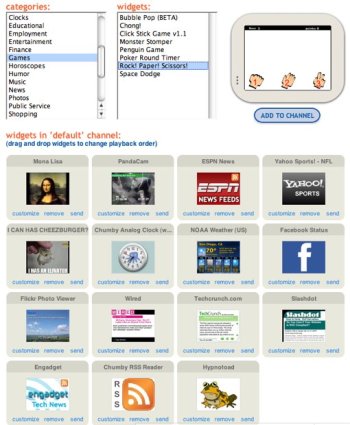Author: Lisa Hoover
I’ve been pacing the chumby maternity ward for nearly a year, waiting for this unique wireless device to see the light of day. I recently took delivery of my own little bundle of chumby joy and, at first look, I think it will make a great addition to my growing gadget family.
The chumby falls squarely into the category of things you don’t know you need until you have one. It’s a compact tabletop device, just a bit bigger than a coffee mug, that connects wirelessly to the Web and uses widgets to display information from popular Web sites like Flickr, The Weather Channel, ESPN News, and Facebook. Users interact with the chumby via its touchscreen to select widgets, set the clock and alarm, check the calendar, and access the playlist of a USB-connected iPod. Though it’s only a first-generation device, the chumby is remarkably versatile.
Specs and features
Out of the box, the chumby comes equipped with Wi-Fi connectivity, a 3.5-inch LCD color touchscreen, 350MHz ARM processor, 64MB SDRAM, 64MB NAND flash ROM, 2W internal stereo speakers, two external USB 2.0 full-speed external ports, a headphone output, accelerometer, squeeze sensor, and an AC adapter.
To enjoy the device’s features, users must activate it via the chumby Web site. Though you must register to access and download widgets, the service is free and supported by the site’s sponsors.
Activation is quick and painless. Simply turn the unit on, and it autodetects any wireless networks within range. You’re asked to calibrate the touchscreen and update the firmware. At the Web site, enter the activation code supplied by the device, and begin downloading widgets to your chumby.

There are dozens of widgets to choose from in 26 categories, including Weather, Finance, Entertainment, News, Sports, and Shopping. You can organize the widgets at the Web site, drag and drop them in the order you wish them to appear on chumby’s screen, select how long each will show onscreen, and customize several (such as the weather and clock widgets) according to your location.
Many widgets, like Hypnotoad and Eyeball (an eye whose sole purpose is to stare creepily at you), were created by members of the chumby community simply for entertainment purposes. Others, however, link to popular Web sites like Slashdot and The New York Times to provide news and information. There is even a widget for RSS feeds from sites of your choosing.
Chumby is more than just a collection of onscreen widgets, though. With two built-in alarm clocks, it can reside on your nightstand to wake you up in the morning. Since it supports iPod music players (no other MP3 players are supported at this time), chumby can live in the kitchen or home office, charging or playing tunes while news, weather, and pictures from your Flickr account scroll across the screen.
Steve Tomlin, CEO of Chumby Industries, says the USB ports are good for more than just playing or charging your iPod. Though he declines to give specifics, on the corporate blog Tomlin says, “More USB-enabled add-ons are coming from us, both real products that add capability to your chumby and other cool little hacks.” He also hints that the as-yet-unused microphone on the front of the device will soon see action as well.
Hackable inside and out
One interesting feature that sets the chumby apart from other wireless touchscreen devices on the market is that its fully hackable — from the open source code that drives the inner workings, to the external leather housing that’s designed to be folded, spindled, and mutilated into whatever form its owner dreams up. Some “chumbyistas” are working to develop a chat platform, a caller ID listener, and even a way to use the device to remotely control lights and lawn sprinklers.
According to the Web site, overzealous hacking may end up voiding the chumby’s warranty, but its creators are active in the product’s forums and wiki to help people safely develop programs and otherwise alter the unit without an overly large risk of ending up with a little paperweight instead of a functioning device.
But does it work?
Since the chumby is such a new device, I expected to encounter some snafus and snags as I played with it. Surprisingly, the only issues I encountered were at the Web site, not with the unit itself.
The touchscreen is very responsive but requires a firm enough tap that simply brushing it accidentally won’t invoke commands you don’t intend. The controls feel as if they lag a bit, but I’m used to working on computers with speeds of 2+ GHz, so 350MHz is bound to feel sluggish in comparison. I expected the 64MB of SDRAM and ROM to feel restrictive, but since the unit is small and meant to do only a couple of things at once (play music and display one widget at a time), a whole bunch of memory really isn’t necessary. If you’re motivated to add storage, however, you can use a thumb drive in one of the USB ports.
I connected an iPod loaded with approximately 6,700 songs to my chumby, and it was able to index them and present my playlists in roughly two minutes. Sound quality was surprisingly good, and the volume was easily controlled via the chumby, but not concurrently with the iPod. Music can be set to play in the background while the unit continues to display widgets, or you can leave the music control display panel on instead.
Though most of the widgets currently available simply slurp information from Web sites and display it onscreen, there are a couple that are slightly more interactive. The Facebook Status widget, for example, continually updates your friends’ status messages on the device, along with the number of emails, requests, and notifications you have waiting. An accompanying “virtual chumby” API is available to use on your Facebook page to display what’s showing on your actual device at any given time. While it’s a good theory, it’s not very well thought out. I downloaded a Flickr widget and set it to display only personal photos of friends and family, but discovered they were displaying on my Facebook virtual chumby as well.
The only minor annoyance I encountered while testing the chumby were at the Web site while downloading widgets. When attempting to customize them, the input fields in the pop-up box frequently disappeared, though clicking the newly blanked area usually worked anyway. I replicated this on more than one computer using Firefox 2.0, so it’s a safe bet there’s a small glitch on the site somewhere.
Obviously, the chumby isn’t meant to replace a desktop computer, or even a handheld one. Instead, it’s a great device to perch on a table in your kitchen or family room so you can keep an eye on the news, monitor your eBay auctions, or watch YouTube videos. If anyone accuses you of being overly tied to the Internet, just tell them you relax by watching the Panda Cam.
Chumby is not yet available to the public, but it’s scheduled to go on sale later this year, and expected to retail for less than $200.
Categories:
- Reviews
- Handheld Devices



